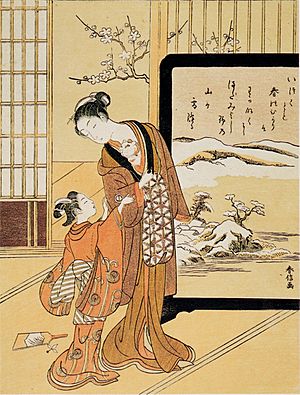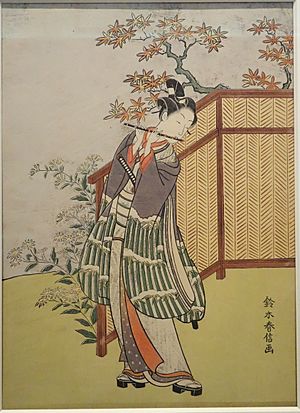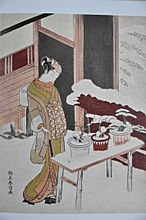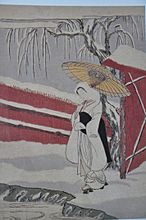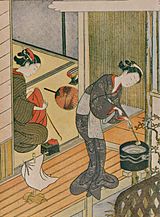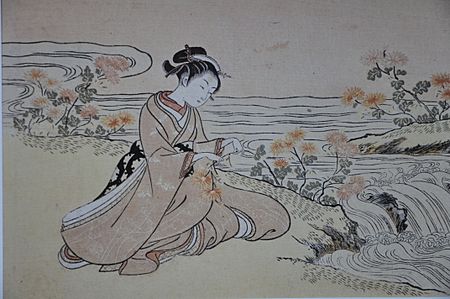Suzuki Harunobu facts for kids
Suzuki Harunobu (Japanese: 鈴木 春信; around 1725 – 8 July 1770) was a Japanese artist. He designed woodblock prints in the ukiyo-e style. Harunobu was a true innovator. In 1765, he was the first to create full-color prints called nishiki-e. This made older two- and three-color prints less popular.
Harunobu used many special techniques in his art. He showed a wide range of subjects. These included scenes from old poems and pictures of beautiful women of his time. Many artists copied his style during his life and soon after. Some, like Harushige, even bragged about being able to copy his work. We don't know much about Harunobu's early life.
Contents
Harunobu's Artistic Influences
Some experts believe Harunobu was from Kyoto. They point to possible influences from an artist named Nishikawa Sukenobu. However, much of Harunobu's work, especially his early pieces, is in the Edo style.
His art shows influences from many other artists. These include Torii Kiyomitsu, Ishikawa Toyonobu, and the Kawamata school. But the biggest influence on Harunobu was the painter and printmaker Nishikawa Sukenobu. Sukenobu might have even been Harunobu's direct teacher.
Harunobu's Art Career
We don't know much about Harunobu's early life. His birthplace and birthdate are not known. But it is thought he grew up in Kyoto. He was said to be 46 years old when he passed away in 1770. Unlike most ukiyo-e artists, Harunobu used his real name. He came from a samurai family.
Harunobu started his art career in the style of the Torii school. He made many skilled works. But these early pieces were not very new or special. Harunobu began to try new styles and formats. This happened when he started working with a group of smart samurai who loved art.
Creating Full-Color Prints
In 1764, Harunobu was chosen to help these samurai. They were making special calendar prints as a hobby. Harunobu was friends with many important artists and scholars of his time. He was also friends with some people close to the shōgun (Japan's military ruler).
Harunobu's calendars showed the calculations of the lunar calendar. People would trade these prints at gatherings and parties in Edo. These calendar prints became the very first nishiki-e, or "brocade prints."
Because his samurai supporters were wealthy, Harunobu used the best materials. He tried better woods for the woodblocks, like cherry wood instead of catalpa. He also used more expensive colors. He applied the colors thicker to make them look more solid.
New Printing Techniques
The most important new idea from Harunobu for nishiki-e was using many separate wood blocks. This was expensive, but his rich clients could afford it. Just 20 years before, a technique called benizuri-e allowed printing in three or four colors. Harunobu used this new method for ukiyo-e prints. He used up to ten different colors on one sheet of paper.
This new technique used special notches and wedges. These held the paper in place. This made sure the different color printings lined up perfectly. Harunobu was the first ukiyo-e artist to regularly use more than three colors in each print. Nishiki-e were full-color images, unlike earlier prints. Since this technique was first used in a calendar, we know it started in 1765.
Later Works and Fame
In the late 1760s, Harunobu became a main artist for pictures of beautiful women (bijin-ga). He also made prints of actors and other subjects for art lovers in Edo. Sometimes, the name of the person who ordered the print appeared on it. This was a new idea in ukiyo-e at that time.
Between 1765 and 1770, Harunobu created over twenty illustrated books. He also made over one thousand color prints and several paintings. He became known as the master of ukiyo-e during these last years of his life. Many artists copied his work. After his death, new artists like Katsukawa Shunshō and Torii Kiyonaga became more popular.
Harunobu's Unique Style
In addition to his new printing methods, Harunobu's personal style was special. His figures are often very thin and light. Some people say all his figures look like children. But it is these young figures that truly show Harunobu's unique style. Richard Lane described it as "Harunobu's special area." He said Harunobu was better than all other Japanese artists at showing "eternal girlhood in unusual and poetic settings."
Harunobu's pictures, like most ukiyo-e prints, might seem simple. But Harunobu cared about the whole picture. Unlike many artists before him, he did not want the girls' kimonos to be the only thing people noticed.
Harunobu is also praised for showing everyday city life in Edo. His subjects were not just geisha, actors, or sumo wrestlers. He also showed street vendors and errand boys. These pictures help us understand the culture of that time. His work often refers to old Japanese poems. But his pictures sometimes gently make fun of the subject.
Many of his prints have a solid, single-color background. This was made using a technique called tsubushi. Many other artists used this method. But Harunobu is known for using it in the most powerful way. The colored background sets the mood for the whole image.
Museum Collections

Harunobu's art can be found in many museums around the world, including:
- Asian Art Museum
- British Museum
- Brooklyn Museum
- Harvard Art Museums
- Hill-Stead Museum
- Kislak Collection of Japanese Prints
- Metropolitan Museum of Art
- Museum of Fine Arts, Boston
- National Museum of Korea
- Nelson-Atkins Museum of Art
- Philadelphia Museum of Art
- Portland Art Museum
- Suntory Museum of Art
- University of Michigan Museum of Art
- Victoria and Albert Museum
- Virginia Museum of Fine Arts
Harunobu on Stamps
Harunobu's artworks have appeared three times on commemorative postage stamps from the Japanese post office:
- 1957 Philatelic Week
- 1969 16th Universal Postal Union Congress
- 1981 Philatelic Week (se-tenant pair)
His works have also been shown on stamps from the Federated States of Micronesia, Sierra Leone, and St Vincent.
Harunobu's Works
- Harunobu
-
A woman after being absent from a joyful meeting, where a geisha plays shamisen behind her.
See also
 In Spanish: Suzuki Harunobu para niños
In Spanish: Suzuki Harunobu para niños


